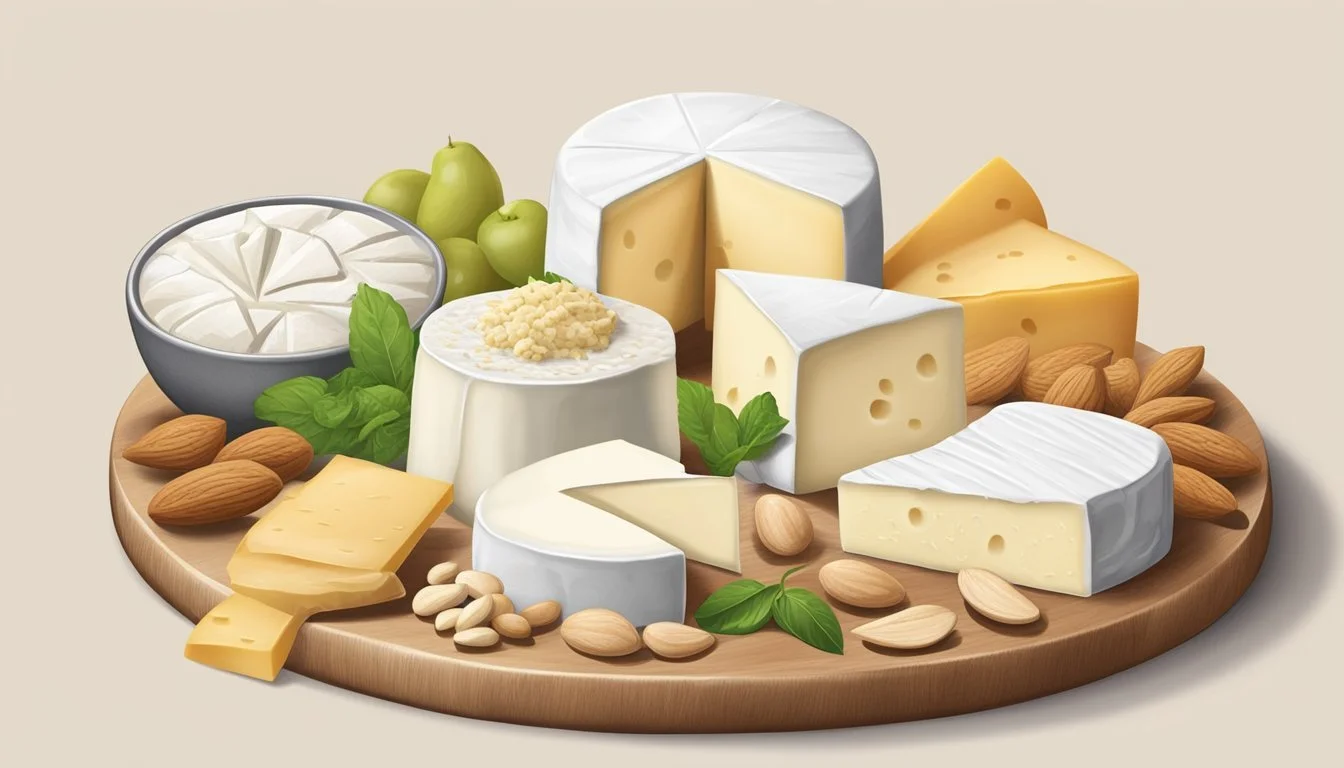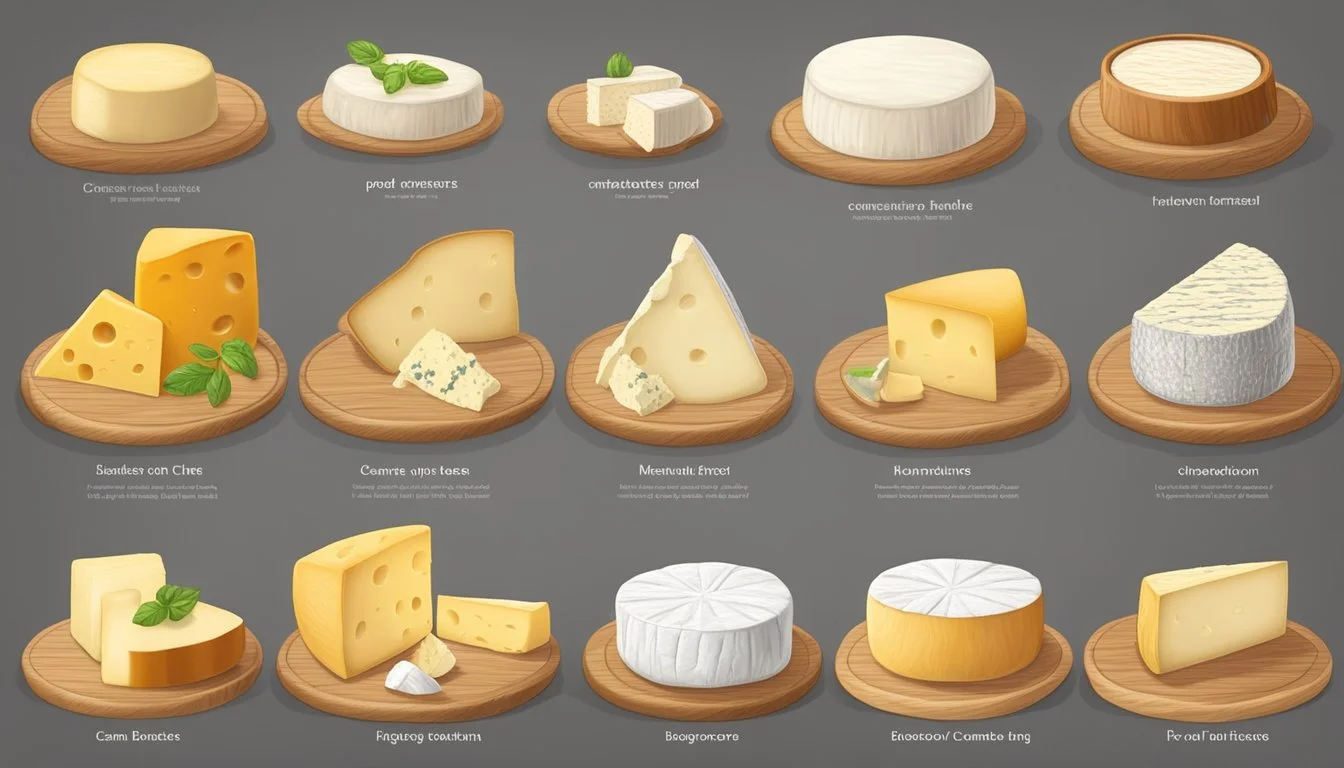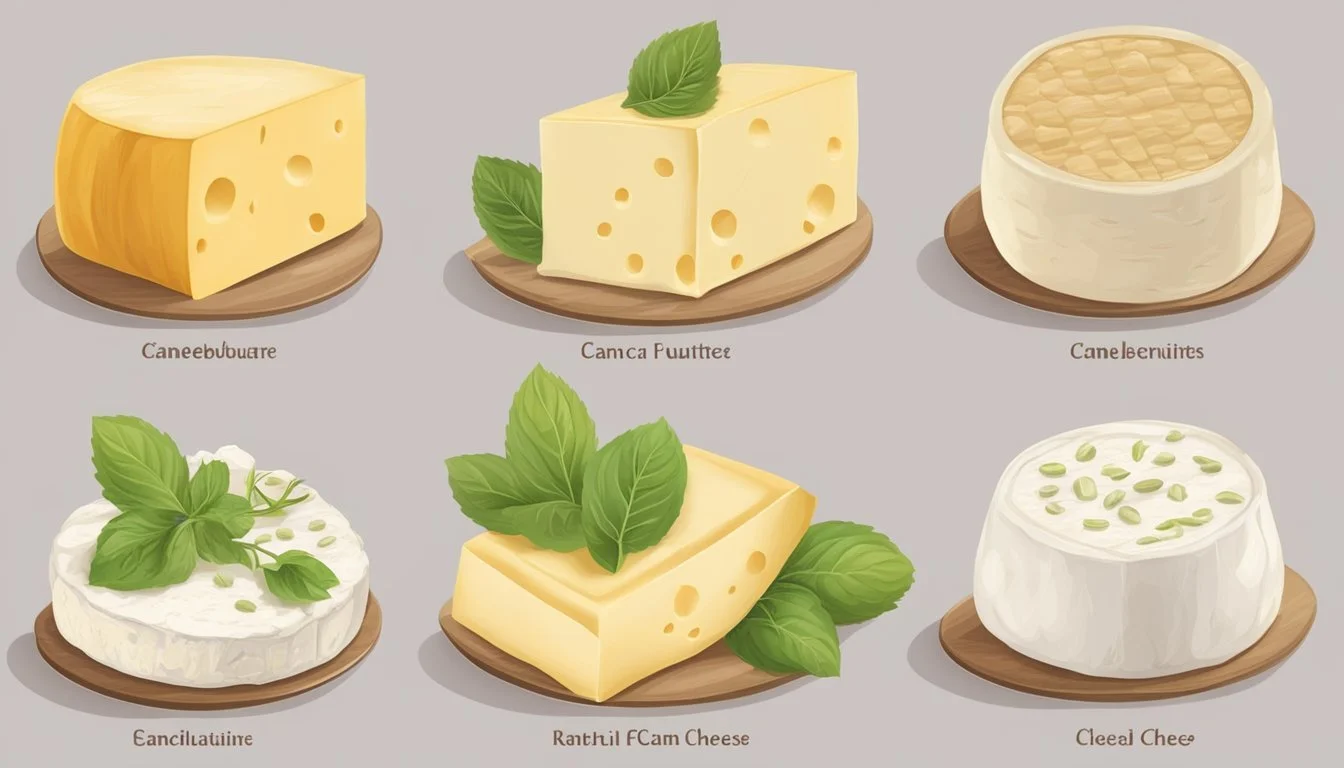Camembert Cheese Substitutes
Top Alternatives for Your Recipes
Camembert cheese (What wine goes well with cheese?), originating from the Normandy region of France, is renowned for its creamy texture and earthy, rich flavor. This soft cheese is often celebrated for its soft, bloomy rind and has become a staple on cheese boards across the globe. Its popularity also lies in its versatility, making it an excellent addition to a variety of culinary dishes. However, at times when Camembert is unavailable, or for those looking for a different taste or texture, choosing a suitable substitute can enhance a dish similarly without compromising on quality.
Certain French cheeses share similarities with Camembert and can serve as effective replacements. Cheeses like Reblochon and Coulommiers display parallel characteristics, such as a creamy consistency and a soft rind, making them favorable alternatives on cheese platters or in cooked dishes. Furthermore, other varieties of cheese, though not French, offer complementary flavors and textures. This broadens the available choices for substitutes, ensuring that recipes calling for Camembert can still be prepared with equally appealing results.
Understanding Camembert Cheese
Camembert cheese is an iconic soft cheese with a rich history and unique sensory characteristics that lend itself to various culinary applications.
Origin and History
Camembert cheese originated in the Normandy region of France during the late 18th century. It was purportedly first made by Marie Harel in 1791, following advice from a priest from Brie. This cheese quickly became a staple in French culture and an emblem of French cheese-making expertise.
Characteristics of Camembert
Flavor Profile: Camembert possesses a distinct earthy flavor with savory, earthy undertones that deepen as the cheese matures. Texture: The cheese has a creamy, buttery texture and a distinctive bloomy rind that encases its soft, yielding body. Body: As it ripens, the body of Camembert cheese becomes runnier and more pronounced in taste.
Culinary Uses
Camembert is extremely versatile in its use. It can be savored on its own with crusty bread or crackers, featured prominently on cheese boards at dinner parties, or included in sandwiches and desserts. It's an important ingredient where the application allows its flavors and textures to shine.
Substitutes for Camembert Cheese
Choosing the right Camembert substitute can enhance a variety of dishes, from classic French recipes to innovative culinary creations. The ideal substitutes offer similar creamy textures and rich flavors suitable for cheese boards, pizzas, or baked recipes.
Cheeses with Similar Profiles
Brie Cheese: Often considered the closest match, Brie's creamy, buttery profile and soft rind offer a similar taste and texture.
Brillat-Savarin Cheese: A triple-cream cheese that brings an indulgent richness that can mimic Camembert's decadent quality.
Reblochon Cheese: This cheese shares the creamy texture of Camembert and often a softer, more buttery flavor.
Alternate Soft Cheeses
Saint-André Cheese: With a bloomy rind and a rich, buttery flavor, it can replace Camembert on a 1:1 basis.
Coulommiers Cheese: A less known but valid alternative, sharing similar production techniques and a very creamy profile.
Goat Cheese (Chevre): For a tangier taste with a distinct flavor profile, soft goat cheeses can serve as an alternative.
Vegan and Dairy-Free Alternatives
Plant-Based Cheese: Various vegan options designed to mimic soft cheese textures, with none to mild tanginess.
Dairy Alternatives: Look for soy-based or nut-based products that aim to replicate the creaminess of traditional cheeses.
Making Your Own Substitute
Homemade Alternatives: Using a blend of cheeses like ricotta and a touch of blue cheese, like Gorgonzola, can emulate Camembert’s flavor in recipes.
Production Techniques: Understanding key characteristics like texture and flavor profile helps in crafting an effective homemade substitute.
Taste and Texture Profiles
When selecting a substitute for Camembert cheese, one must consider the primary flavors and textures of the alternatives to ensure they complement the dish as intended.
Comparing Primary Flavors
Camembert cheese is renowned for its rich, buttery and earthy flavor profile, with a hint of slightly acidic notes that add complexity. Substitutes should offer a balance between creamy richness and that characteristic tang. For example:
Toma Cheese: Shares a nut-like flavor with a subtle buttery taste, making it a suitable alternative.
Cream Cheese: Lacks the earthy notes but provides a mild taste and slight tanginess, offering a different yet pleasant flavor profile.
Texture Similarities and Differences
The texture of Camembert is distinctively soft, gooey, and creamy. It's important that substitutes mimic this texture to some extent, either in its spreadable nature or through a similar gooey consistency when melted. Here's how some substitutes compare:
Toma Cheese: It's often soft-ripened, implying a creaminess akin to that of Camembert, though not as chalky near the rind.
Cream Cheese: Extremely spreadable and smooth, it provides a similar creaminess, but it isn't aged or ripened, which results in a different textural experience.
Using these guidelines, one can seek out substitutes that maintain the integrity of dishes traditionally made with Camembert cheese.
Nutritional and Allergen Information
When considering substitutes for Camembert cheese, it is important to assess the nutritional content and potential allergens that these alternatives may contain. This section focuses on the lactose and dairy content, as well as comparing the calcium and other nutrients found in various substitutes.
Lactose and Dairy Content
Camembert cheese, like all traditional dairy-based cheeses, contains lactose. Individuals with lactose intolerance or a dairy allergy may experience adverse reactions to Camembert and will need to choose substitutes carefully. Here is a brief overview of lactose and dairy content in some Camembert substitutes:
Reblochon/Coulommiers: These cheeses are similar in methodology to Camembert and also contain lactose.
Cream Cheese: Made from cow's milk, it contains lactose, but often in lower amounts compared to aged cheeses.
Dairy-Free Alternatives: Substitutes made from nuts, soy, or other plant-based materials are lactose-free and suitable for those with dairy allergies or lactose intolerance.
Calcium and Nutrient Comparison
Calcium is a vital mineral often associated with dairy products. Camembert cheese provides a respectable amount of calcium, but how do its substitutes measure up?
Calcium in Camembert: A 1-ounce serving contains about 85 mg of calcium.
Calcium in Plant-Based Substitutes: Varies widely; some are fortified with calcium and other nutrients to mimic dairy cheese nutritional profiles.
Additionally, nutrient composition in cheese substitutes can vary, with some offering comparable amounts of protein and fat, while others may have a different nutritional balance. For those looking to maintain dietary calcium intake, it may be beneficial to check the nutritional labels of substitutes to ensure they meet the necessary requirements.
Be aware that while cheese alternatives can be comparable in texture and flavor, nutritional profiles differ and may not meet the specific dietary needs of every individual.
Pairing with Foods and Wines
When seeking substitutes for Camembert cheese, it's essential to consider how the alternative will interact with foods and wines to maintain the harmony of flavors and textures typically provided by Camembert. This section provides guidance on curating cheese boards and selecting complementary wines.
Creating a Balanced Cheese Board
A cheese board inspired by Camembert should include a mix of flavors and textures to cater to different palates. When substituting Camembert, aim for a cheese that presents earthy undertones and a creamy texture. One may consider the following items to accompany the substitute:
Fresh fruits: such as sliced apples or berries to add a refreshing contrast.
Nuts: for a crunchy texture, like walnuts or almonds.
Charcuterie (What wine goes well with charcuterie?): a selection of fine meats can enhance the richness of the cheese.
Bread or crackers: to serve as vessels for the cheese and other board components.
These elements come together to create not just a cheese board, but a culinary masterpiece that pleases the senses.
Wine Pairings and Recommendations
Selecting the right wine to complement the chosen Camembert substitute is crucial for a sophisticated gastronomic experience. Below are specific recommendations to create memorable pairings:
Sauvignon Blanc or Pinot Grigio: Ideal for milder substitutes, as their crispness complements the buttery taste often associated with Camembert.
Chardonnay: A classic pairing for young, creamy cheeses due to its balanced acidity.
Cider: Especially when dealing with an earthier cheese profile, to echo the terroir-centric essence of traditional Camembert pairings.
Champagne: For a luxurious pairing, opt for Champagne, especially with a substitute cheese that has reached a delightfully oozy stage.
Wine Type Cheese Substitute Characteristic Why it Works Sauvignon Blanc Mild, Buttery Crispness Balances Richness Pinot Grigio Mild, Buttery Light and Refreshing Chardonnay Young, Creamy Acidity Cuts Creaminess Cider Earthy, Robust Complements Terroir Champagne Oozy, Ripe Bubbly Contrast
These recommendations are made with confidence that the gourmet recipes involving Camembert can still be enjoyed to their fullest with suitable alternatives, perfectly paired with the right wine.
Regional Alternatives to Camembert
When seeking alternatives to Camembert, there is a plethora of regional cheeses that can satisfy the craving for that creamy, soft-rind experience. These cheeses are unique to their locales but share enough characteristics with Camembert that they make suitable substitutes.
From France, some Camembert alternatives include:
Reblochon: This semi-soft cheese comes from the Savoie region with a creamy texture, offering a mild, nutty flavor characteristic of French alpine cheeses.
Coulommiers: Often considered a close relative to Camembert, Coulommiers belongs to the Brie family. It hails from the town of Coulommiers in the Brie region, boasting a similar, albeit slightly denser, creaminess.
Across different ** European regions**, the following cheeses are notable alternatives:
Saint-André: This rich, triple-crème cheese provides a luxuriously smooth texture. It's not from Normandy but maintains a bloomy rind reminiscent of Camembert.
Chaource: Originating from its named region in Champagne, this cheese offers a similar bloomy rind with a creamy interior that can rival Camembert’s softness and depth of flavor.
In the United States, one can find:
Harbison: An American creation from Vermont, Harbison presents a woodsy, bark-wrapped exterior. The cheese itself is soft and spreadable with a unique flavor profile that stands on its own but can also act as a substitute for Camembert in many dishes.
Each of these cheeses reflects the particular terroir and cheese-making traditions of their regions, giving cheese lovers a range of options to explore the depths of soft-ripened cheeses beyond the well-loved Camembert.




